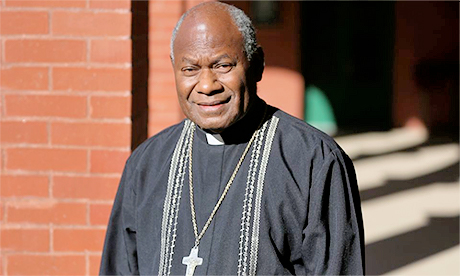Rising seas and new technology to mine beneath them are forefront concerns these days for Cardinal John Ribat of Papua New Guinea.
During a 12-day U.S. trip along the East Coast that concludes March 22, the head of the Port Moresby archdiocese on the South Pacific island nation has in numerous settings expressed his worry with the continuing impact of climate change on his and other islands, as well as the development of first-of-its-kind deep seabed mining in waters off his homeland.
Ribat, 61, has long spoken out about the impacts of climate change on the people of the Pacific islands, considered one of the ground zeros of global climate change, where rising seas have submerged portions of islands and have already led to communities relocating from their homes to nearby islands.
Last week, Ribat raised his concerns about climate change again on Capitol Hill in meetings with Sen. Edward Markey (D-Massachusetts) and officials for Sen. Jeff Markley (D-Oregon). Both sit on the Senate Committee on Environment and Public Works, and its subcommittee on fisheries, water and wildlife.
In their meeting, the cardinal pointed out on a map to Markey, who is Catholic, the locations of the islands as he described how rising seas have forced people to relocate farther inland every few years as the tides rise and come in farther themselves.
On Bougainville, one of Papua New Guinea’s roughly 600 offshore islands, the diocese has offered a piece of land to help people resettle from the Carteret Islands, which have shrunk under rising ocean tides.
Ribat said that during a trip around Easter last year to Ahus and Andra islands he witnessed similar scenes of shorelines and agricultural lands that had washed away.
Sea level rise is driven by two primary factors: the oceans expanding as waters warm, and increased water mass due to melting ice from glaciers and ice sheets.
According to a climate science special report, published in November and compiled by 13 U.S. federal agencies,
- global mean sea levels have risen roughly 7 to 8 inches since 1900
- three inches since 1993, with
- human-driven climate change making “a substantial contribution” during that period.
Scientists project further rise of 1 to 4 feet by 2100 and have not ruled out a rise as high as 8 feet.
“When you’re on an island, you get it, when you got to keep moving your house,” said Franciscan Fr. Michael Lasky, who helped organize the cardinal’s trip.
In the Capitol Hill meetings, Ribat also raised another problem accompanying rising tides: seawater seeping into the freshwater table underground and turning some crops inedible. “When they harvest them it’s salty.
They cannot eat them anymore because the sea is rising,” he said.
Clean water impacted
The impact of rising seas on clean water came up as well during a meeting March 15 with officials at the U.S. Environmental Protection Agency.
He also reiterated concerns he shared with the senators’ offices about new seabed mining technology set to begin next year in waters east of Papua New Guinea.
Nautilus Minerals, a Canadian-based company, in 2011 received a mining lease from the Papua New Guinea government for extracting deposits of copper and gold from the floor of the Bismarck Sea.
The project will be the world’s first attempt at mineral extraction from the deep sea.
The mining operation — which would occur 1,600 meters, or nearly 1 mile, under the sea about 20 miles off the western coast of New Ireland and 31 miles north of New Britain, both islands east of Papua New Guinea — is set to begin in 2019.
According to Nautilus, the deposits of the deep sea Solwara 1 Field (“salt water” in the Tok Pisin language native to Papua New Guinea) contain copper and gold at grades much higher than typically found in land-based mines.
The potential mining site holds added significance for Ribat, who calls home Watom Island, off New Britain’s north coast.
While on the island at Christmas, fishers shared with him anxieties over how the mining may impact fishing grounds. Continue reading
- Image: NCR
